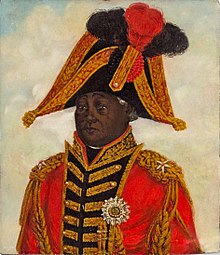Kingdom of Haiti
The Kingdom of Haiti,[1] or Kingdom of Hayti[2] (French: Royaume d'Haïti;[3][4] Haitian Creole: Wayòm an Ayiti), was the state established by Henri Christophe on 28 March 1811 when he proclaimed himself King Henri I after having previously ruled as president of the State of Haiti, in the northern part of the country.
His 16-year-old son and heir, Jacques-Victor Henri, Prince Royal of Haiti, was murdered 10 days later at the Sans-Souci Palace by rebels.
Parallel with the government of Christophe in the north, Alexandre Pétion, a free person of color, ruled over the south of the country as President of the Republic of Haiti until his death in 1818.
But after a last battle fought on the north–south border, in which the king ordered to shoot all the southern officers who were prisoners, republican ideas circulated more and more in the kingdom.
As for the king, he suffered a stroke in August 1820, which left him partially paralyzed and considerably weakened his health and disturbed his thinking.
The revolution quickly broke out in the North, the richest city of the kingdom, Cap-Haïtien, fell under revolutionary control.
Suffering from paralysis and seeing that the situation was slipping away from him, the king committed suicide on 8 October 1820,[6] by shooting himself in the heart with a silver bullet during a mass in a church he had built.
After his death, his son, Crown Prince Victor-Henry, was proclaimed king by his followers under the name of Henry II.
Boyer took advantage of the revolution to send his army, present on the border, to the center of the northern kingdom.
To put an end to his troubles, the king established the "Code Henri", which was composed of a set of laws and promoted education.
When he became king, Henry appointed Joseph Rouanez as chancellor, and also granted him the title of Duke de Morin.
With an edict dated 5 April 1811, King Henry proclaimed a noble class whose titles, ecu, and currencies were intended to be transmitted hereditarily.
In addition to the main body, a chapel with a large cupola was also built, as well as numerous annexes: barracks, a hospital, ministries, a printing shop, a mint, a school, an art academy, and abfarm, etc.
King Henri, his wife Queen Marie-Louise, and their children – including Victor-Henry Christophe – lived in the palace, along with their staff and the various councillors and ministers, until the fall of the monarchy on 18 October 1820.
The king owned nineteen other plantations and had other residences and forts built throughout his kingdom, including the La Ferrière citadel, which was located a few kilometers from the palace and armed with 200 cannons.
The geographical location of this royal residence and the citadel was chosen for strategic purposes, i.e. it was both central and elevated, as well as concealed and perfectly autonomous.
Furthermore, it allowed the sovereign to control his territory and to protect himself from his internal and external enemies, including the French, who still sought to retake their former colony.



